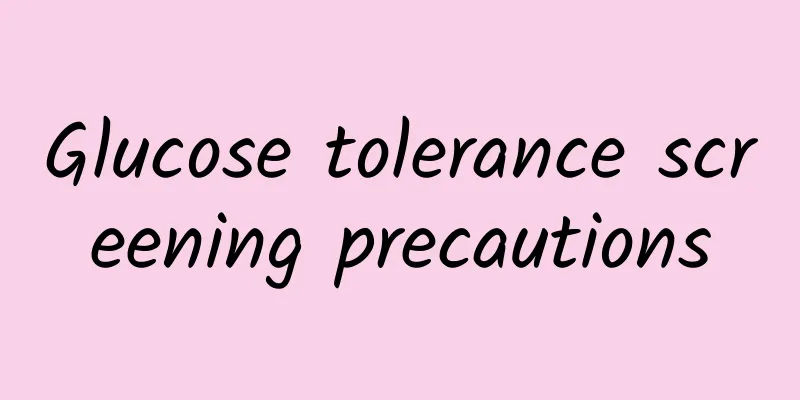Glucose tolerance screening precautions

|
Glucose tolerance screening, also known as glucose screening, is a relatively important prenatal examination item, which is mainly used to check the blood sugar level in the pregnant woman's body and confirm whether the pregnant woman's body is healthy. In order to make the results of the glucose tolerance test more accurate, pregnant women must be well prepared before the glucose tolerance screening, pay attention to a reasonable diet, keep their emotions stable, avoid strenuous exercise, and be sure to fast. Here are some things to note before doing a glucose tolerance test. 1. Precautions before glucose tolerance test 1. Eat normally 3 days before the test In the three days before the test, the carbohydrate intake (i.e. rice and pasta) should not be less than 150 grams. If the subjects deliberately reduce the amount of staple food, the test results will be inaccurate, leading to misdiagnosis. 2. Avoid strenuous exercise and keep your emotions stable Normal physical activity should be performed 3 days before the test. However, strenuous exercise before the test can excite the sympathetic nerves and increase blood sugar. Infection, trauma, and drastic mood swings can all excite the sympathetic nerves and affect the results of glucose tolerance tests. 3. Be sure to eat on an empty stomach When doing a glucose tolerance test, the expectant mother must fast for 8 to 14 hours to truly reflect the fasting blood sugar level. For example, if you are doing a glucose tolerance test at 8 o'clock in the morning, it is best not to eat since 10 o'clock the night before. You can drink water, but not tea or coffee. The first fasting blood sample is used to measure the sugar level in the blood, called a basal test. 2. Precautions for taking glucose tolerance test 1. Do not eat during the experiment During the experiment, you are not allowed to smoke, drink water or eat. You can walk around a little, but avoid early morning exercise. In addition, expectant mothers do not need to be nervous and should not let their emotions fluctuate due to multiple blood draws. They should try their best to cooperate with medical staff in drawing blood samples each time. 2. Special circumstances If you experience symptoms such as pale complexion, nausea, or fainting during the examination, stop the test. If the above symptoms appear 3-4 hours after taking sugar, it should be considered as reactive hypoglycemia. Blood should be drawn immediately to measure blood sugar and the patient should be allowed to eat. 3. Precautions after the glucose tolerance test In the sugar screening test, the statistics of various reference values are also the values obtained after integrating a large number of samples. The test results of sugar screening are erroneous. Due to objective factors such as individual differences or technical problems, these errors are difficult to avoid. |
<<: What to do if the glucose tolerance is high for two hours
>>: Is it normal to have leucorrhea during breastfeeding?
Recommend
How to correct inverted nipples
Retracted nipple is a relatively common disease m...
Symptoms of dryness
Zang-zao syndrome is actually irritable bowel syn...
Side effects of Chinese medicine skin peeling
As we age, our skin elasticity will generally bec...
What is the most effective way to reduce acne scars?
Acne scars greatly affect the beauty of the face,...
Complications of gastric ulcer, timely treatment to reduce harm
If gastric ulcer is not controlled in time, it is...
Blue discharge on underwear
If there is blue discharge in the underwear, it i...
The efficacy and role of Sichuan Army
Sichuan army is a plant native to the Sichuan reg...
How can people who easily gain weight lose weight?
Many people are obese due to physical problems. F...
What is the treatment for pituitary microadenoma?
The pituitary gland is a tissue located in the ce...
Which part of the body does pelvic pain occur in pregnant women?
The bitterness and sweetness during pregnancy are...
What food is good for cold and cough
Colds are very common in life, especially in spri...
Can patients with renal insufficiency take Panax notoginseng powder?
The kidney is one of the most important organs in...
There is a pimple in my cheek that moves
We all care about our faces. Boys will wash their...
Chinese medicine for nourishing ovaries
A woman’s skin can reflect many physical problems...
Anti-epileptic drugs with minimal side effects
Epilepsy is a type of brain dysfunction that is p...









